6zfshdb
Well-Known Member
- Region
- USA
- City
- Northeast Pennsylvania
At 74, I'm always on the lookout for products that will allow me to continue riding as long as possible. I sometimes get arthritis in my hands which makes it difficult and sometimes painful to shift gears on a standard cable actuated derailleur system. I've looked at electronic derailleur systems but they are expensive and are mostly for 11 speed or higher cassettes. My existing bike is an older 10 speed. To convert it to an 11 speed and add electronic shifting would cost almost as much as a new bike. I was actually considering going that route until I found this product from Archer Components:

 archercomponents.com
archercomponents.com
The D1X Trail mounts to the chain stay or seat stay of almost any bike, electric or conventional that uses a derailleur. It works with any cassette up to 15 cogs. At close to $400, it isn't cheap but a lot more so than any other electronic shifting system. Considering Archer's no questions asked 30 day return policy and 2 year warranty, I decided to give it a try. I have to say, after using the product for almost 500 miles, I'm impressed! Installation took about a half hour with another 20 minutes devoted to fine tuning the adjustments. Once set, the D1X holds your adjustments perfectly even when the batteries are changed. Shifting is quick, smooth and more "positive" than any cable system I've used. The handlebar mounted remote comes in light or firm button actuation pressure and is a huge benefit for anyone with finger or hand issues.
I won't get into the details since most are well explained in the link above. I'll simply highlight a few points that aren't clear in the instructions.
In my case, I had to mount the shifter on the seat stay since there are cables & electrical connectors in the way on the chain stay. The cable supplied was too short so I had to buy a longer piece of Bowman cable.
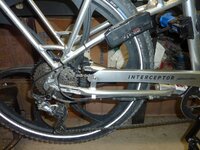
Once installed, the shifter is adjusted using a free app available for Android or iPhone. Micro adjustments along with temporary "overshifting" make the shifting process as smooth as butter! One point that isn't clear in the instructions is, you need to pair the shifter with the app BEFORE pairing the remote. The app will not work when the shifter is paired with the remote.


The Bluetooth remote can be mounted on the left or right, which ever is more convenient. As a precaution, I moved the cable shifter mechanism out of the way temporarily and left the cable in place rather than remove them. That way, it could be easily reinstalled should something happen to the electronic shifter.
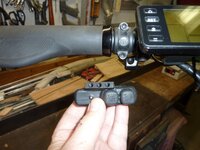
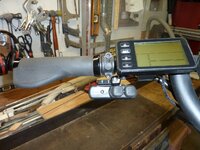
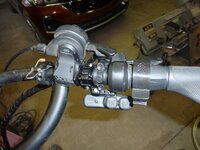
My only real complaint with the Archer D1X Trail is the way the batteries are installed. They are a snug fit in the shifter and it needs to be removed from the chain stay to change them. This is a tedious process and difficult to do on the road or trail. It is sometimes possible to remove the battery cover, lift the rear wheel and tap the side of the shifter. If you're lucky, the batteries will slide out but most of the time, they don't. I found a way to simplify the process by using a magnetic pick up tool to extract the batteries. I carry it in the spare battery kit that Archer sells for $15.
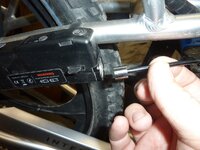
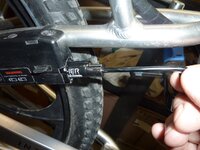
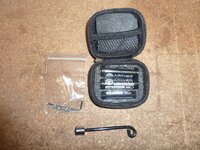
Changing the battery on the remote is almost as difficult. It is almost impossible to do without removing it from the bike. This requires carrying the proper size Torx wrench in your tool kit. The small Allen wrench needed to open the case and extra screws are part of the spare battery kit which is a recommended accessory.
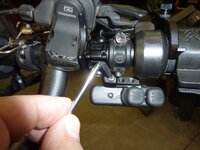
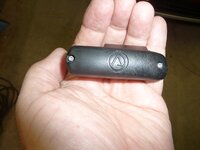
The system operates for around 80 hours per charge which means the average rider won't have to change batteries more than a few times each season. As an example, the picture of the app battery meter above, taken after 300 miles of riding, shows them to be about half discharged. In this case, I rode around 50 miles on 6 different days during a 30 day period.
Is electronic shifting really necessary? I suppose it depends on your needs and abilities. Aside from it's ease of operation for those with health issues, the biggest advantage is the time saved having to constantly adjust your derailleur. Many riders aren't able to do this themselves and rely on a bike shop to do the work. Unlike cable actuated systems, the performance of electronic shifters does not change over time. There is no cable & shifter mechanism to clutter up the look of your handlebars.
Is it worth the money? In my case, yes but not everyone will agree.
I apologize if this post seems to be a product endorsement. In a way, I guess it is but aside from being a satisfied customer, I am in no way associated with Archer Components.

D1x Trail Shifter w/ Micro-Adjust Remote
30-day Money Back Guarantee! The D1x Trail adds high-performance electronic shifting to any rear derailleur. Get smooth, precise shifting no matter what you ride. 1x, 2x, 3x? SRAM, Shimano, Box, TRP? The D1x plays nice with everybody! Our Micro-Adjust Remote lets you fine tune each gear from the...
The D1X Trail mounts to the chain stay or seat stay of almost any bike, electric or conventional that uses a derailleur. It works with any cassette up to 15 cogs. At close to $400, it isn't cheap but a lot more so than any other electronic shifting system. Considering Archer's no questions asked 30 day return policy and 2 year warranty, I decided to give it a try. I have to say, after using the product for almost 500 miles, I'm impressed! Installation took about a half hour with another 20 minutes devoted to fine tuning the adjustments. Once set, the D1X holds your adjustments perfectly even when the batteries are changed. Shifting is quick, smooth and more "positive" than any cable system I've used. The handlebar mounted remote comes in light or firm button actuation pressure and is a huge benefit for anyone with finger or hand issues.
I won't get into the details since most are well explained in the link above. I'll simply highlight a few points that aren't clear in the instructions.
In my case, I had to mount the shifter on the seat stay since there are cables & electrical connectors in the way on the chain stay. The cable supplied was too short so I had to buy a longer piece of Bowman cable.

Once installed, the shifter is adjusted using a free app available for Android or iPhone. Micro adjustments along with temporary "overshifting" make the shifting process as smooth as butter! One point that isn't clear in the instructions is, you need to pair the shifter with the app BEFORE pairing the remote. The app will not work when the shifter is paired with the remote.


The Bluetooth remote can be mounted on the left or right, which ever is more convenient. As a precaution, I moved the cable shifter mechanism out of the way temporarily and left the cable in place rather than remove them. That way, it could be easily reinstalled should something happen to the electronic shifter.



My only real complaint with the Archer D1X Trail is the way the batteries are installed. They are a snug fit in the shifter and it needs to be removed from the chain stay to change them. This is a tedious process and difficult to do on the road or trail. It is sometimes possible to remove the battery cover, lift the rear wheel and tap the side of the shifter. If you're lucky, the batteries will slide out but most of the time, they don't. I found a way to simplify the process by using a magnetic pick up tool to extract the batteries. I carry it in the spare battery kit that Archer sells for $15.



Changing the battery on the remote is almost as difficult. It is almost impossible to do without removing it from the bike. This requires carrying the proper size Torx wrench in your tool kit. The small Allen wrench needed to open the case and extra screws are part of the spare battery kit which is a recommended accessory.


The system operates for around 80 hours per charge which means the average rider won't have to change batteries more than a few times each season. As an example, the picture of the app battery meter above, taken after 300 miles of riding, shows them to be about half discharged. In this case, I rode around 50 miles on 6 different days during a 30 day period.
Is electronic shifting really necessary? I suppose it depends on your needs and abilities. Aside from it's ease of operation for those with health issues, the biggest advantage is the time saved having to constantly adjust your derailleur. Many riders aren't able to do this themselves and rely on a bike shop to do the work. Unlike cable actuated systems, the performance of electronic shifters does not change over time. There is no cable & shifter mechanism to clutter up the look of your handlebars.
Is it worth the money? In my case, yes but not everyone will agree.
I apologize if this post seems to be a product endorsement. In a way, I guess it is but aside from being a satisfied customer, I am in no way associated with Archer Components.

